| کد مقاله | کد نشریه | سال انتشار | مقاله انگلیسی | نسخه تمام متن |
|---|---|---|---|---|
| 6550811 | 1421961 | 2018 | 11 صفحه PDF | دانلود رایگان |
عنوان انگلیسی مقاله ISI
Preliminary investigation of aircraft mounted thermal imaging to locate decomposing remains via the heat produced by larval aggregations
ترجمه فارسی عنوان
تحقیقات اولیه برای تهیه تصویربرداری حرارتی هواپیما برای تعیین محل تجزیه باقی مانده از طریق گرما تولید شده توسط توده لارو است
دانلود مقاله + سفارش ترجمه
دانلود مقاله ISI انگلیسی
رایگان برای ایرانیان
موضوعات مرتبط
مهندسی و علوم پایه
شیمی
شیمی آنالیزی یا شیمی تجزیه
چکیده انگلیسی
This study investigated the potential of aircraft mounted thermal imaging (AMTI) to locate surficial decomposing remains (clothed and unclothed) through detection of heat generated by larval aggregations of carrion feeding insects. Two trials were carried out, each utilising four pig cadavers (40-45 kg) as human analogues and exposing them to insect activity in autumn and winter on the Swan Coastal Plain, Western Australia. The Western Australia Police Air Wing helicopter, fitted with a forward looking infrared radiometer (FLIR) camera, was utilised to obtain the AMTI footage of carcasses over time. The helicopter obtained footage on six occasions during Trial 1 and 22 times during Trial 2. The carcasses were visited daily to record temperature data, insect activity and the state of decay. Activity of blow fly larval aggregations and corresponding heat generation was greatest during the active decay stage; in this period surficial remains were strongly detectable by AMTI at distances of up to one kilometre away. The average ambient daytime temperature during autumn was 27.6 ± 3.4 °C and AMTI was most effective 3-8 days after death. During winter the average daytime temperature was 14.2 ± 2.6 °C and AMTI was most effective 10-23 days after death. As the timing of larval aggregation activity varied significantly in different seasons, climatic conditions must be considered when assessing the window of opportunity for AMTI as a viable search technique. Despite climatic variation, the temperature difference between larval aggregations and surrounding soil was remarkably consistent across both seasons (8.9 ± 1.0 °C). AMTI was determined to be most effective between 9 pm and 5 am. A predictive tool for determining the window of opportunity for the successful detection of larval aggregations under Western Australian environmental conditions is provided.
ناشر
Database: Elsevier - ScienceDirect (ساینس دایرکت)
Journal: Forensic Science International - Volume 289, August 2018, Pages 175-185
Journal: Forensic Science International - Volume 289, August 2018, Pages 175-185
نویسندگان
Michael J. Lee, Sasha C. Voss, Daniel Franklin, Ian R. Dadour,
